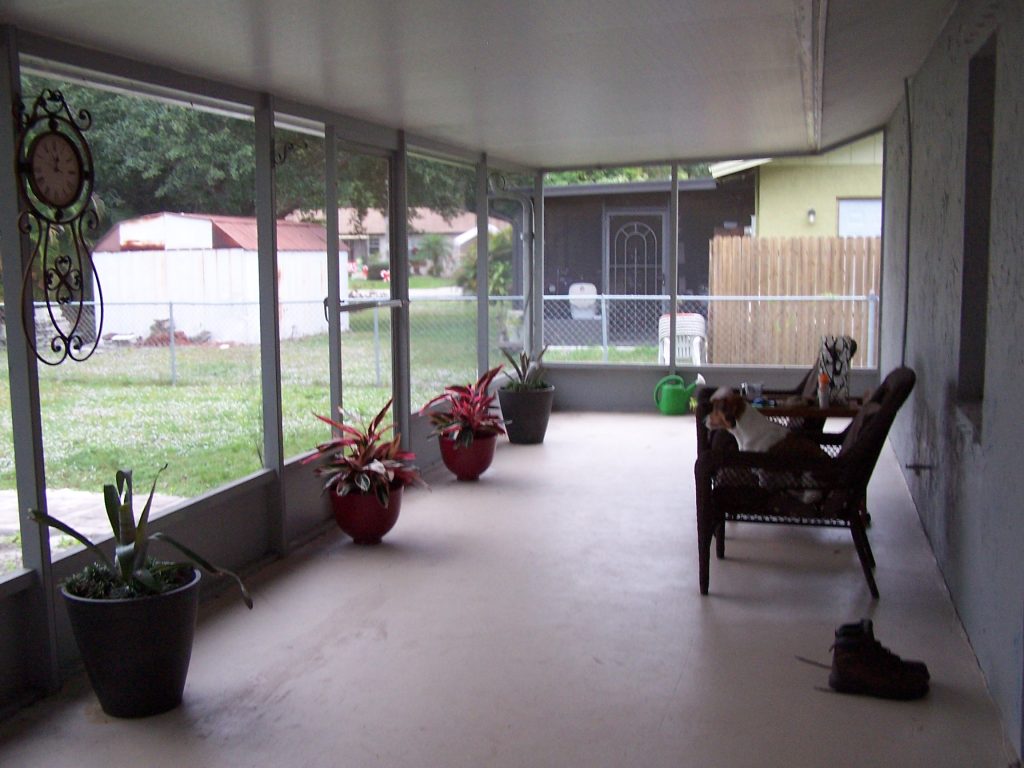Building an enclosed patio is an excellent approach to expanding your living area, combining the comfort of the inside with the beauty of the outside, and raising the value of your property. A covered patio provides a flexible option whether you want to design a comfortable place for morning coffees or a chic space for evening get-togethers.
We’ll look at five easy-to-do DIY enclosed patio ideas in this book that can turn your outside area into a gorgeous haven.
Contents
Creative Enclosed Patio Ideas
Screened-In Patio
A screened-in patio is a perfect solution for enjoying the outdoors without the annoyance of insects. This type of enclosed patio offers an ideal blend of openness and protection, allowing you to savor fresh air and scenic views while staying shielded from pests. With a few tools and materials, you can create a functional and aesthetically pleasing enclosed patio that enhances your home’s outdoor living space.
Materials and Tools Needed
To build your screened-in patio, gather the following materials and tools:
- Aluminum or Wooden Framing: Choose your preferred material for the structure.
- Screening Material: Fiberglass or aluminum screens are popular choices.
- Screen Spline and Spline Roller: These secure the screen into the frame.
- Screws and Anchors: For attaching the frame to your existing structure.
- Measuring Tape and Level: To ensure precise measurements and alignment.
- Saw and Drill: For cutting and assembling the frame.
Step-by-Step Guide to Building a Screened-In Enclosed Patio
- Plan Your Space
- Determine the dimensions of your enclosed patio. Measure the area where you intend to install the screens, considering doorways and existing structures.
- Decide on the type of frame material (aluminum or wood) that best suits your home’s aesthetics and your DIY skills.
- Construct the Frame
- Begin by cutting the framing material to size. Ensure all pieces fit the measured dimensions of your patio space.
- Assemble the frame by securing the pieces together with screws. Use a level to keep the structure straight and square.
- Attach the Frame to Your Patio
- Position the frame against your patio’s outer edge. Use screws and anchors to attach it securely to the existing structure.
- Check that the frame is firmly in place and stable before proceeding to the next step.
- Install the Screening Material
- Cut the screening material to fit the frame sections. Leave a little extra material to ensure a snug fit.
- Place the screen over the frame and use the screen spline to secure it into the grooves of the frame. Roll the spline into place with the spline roller, ensuring the screen is taut and smooth.
- Finish the Enclosure
- Trim any excess screening material for a clean edge.
- Install a door to complete your enclosed patio. Choose a screen door that matches the framing material and style of your enclosure.

Tips for a Perfect Screened-In Enclosure
- Choose the Right Screening Material: Fiberglass screens are flexible and easy to install, making them a good choice for DIY projects. Aluminum screens are more durable and resistant to damage.
- Consider the Climate: If you live in an area with heavy winds or storms, reinforce the frame and screens to withstand the elements.
- Maintain Your Enclosure: Regularly inspect the screens for tears and the frame for any signs of wear. Promptly repair any damage to keep your enclosed patio in top condition.
A screened-in patio not only adds functionality to your home but also enhances its appeal. This enclosed patio design offers a perfect spot to relax, entertain, or simply enjoy the beauty of your garden without the hassle of bugs. With careful planning and execution, your DIY screened-in patio will become a cherished part of your home.

Glass Enclosure
Transforming your patio into a glass-enclosed haven adds a touch of modern elegance to your home. This type of patio enclosure provides unobstructed views of your surroundings while offering a comfortable, weather-resistant space for year-round enjoyment. A glass enclosure is perfect for those who want to maintain a close connection with nature without sacrificing comfort or style.
Materials and Tools Needed
To build a glass enclosure for your patio, you’ll need the following:
- Sliding Glass Panels: Choose high-quality tempered glass for durability and safety.
- Aluminum or Vinyl Framing: These materials are strong, lightweight, and resistant to weathering.
- Track System for Sliding Panels: Ensures smooth and secure movement of the glass doors.
- Sealing Strips: To provide airtight sealing and prevent drafts.
- Drill, Screws, and Anchors: For assembling and securing the frame.
- Level and Measuring Tape: To ensure accurate installation and alignment.
Step-by-Step Guide to Building a Glass Enclosure
- Design and Measure Your Space
- Outline the dimensions of your patio area where the glass enclosure will be installed. Accurate measurements are crucial for ordering the correct size of glass panels and framing.
- Decide on the placement of sliding doors and any fixed glass sections. Consider accessibility and how the doors will open for optimal use.
- Prepare the Frame
- Cut and assemble the aluminum or vinyl framing according to your patio’s measurements. Ensure all cuts are precise to form a tight, stable structure.
- Attach the frame pieces using screws. Double-check the alignment with a level to maintain a clean, straight line.
- Install the Track System
- Mount the track system along the top and bottom of the frame where the sliding glass panels will be installed.
- Secure the tracks firmly with screws and ensure they are level for smooth operation of the sliding doors.
- Mount the Glass Panels
- Carefully position the glass panels into the tracks, starting with the fixed sections if applicable. Handle the glass with care to avoid any damage.
- Slide the movable glass doors into the tracks. Test the doors to ensure they glide smoothly and lock securely.
- Seal the Enclosure
- Apply sealing strips along the edges of the glass panels and frame to create an airtight barrier. This step helps in keeping out drafts and maintaining the interior temperature.
- Inspect all seals and tracks for any gaps or misalignments. Adjust as necessary to ensure a snug fit and optimal performance.
Tips for a Successful Glass Enclosure
- Choose Tempered Glass: Tempered glass is stronger and safer than regular glass, making it ideal for large panels and patio enclosures.
- Ensure Proper Ventilation: Consider integrating vents or operable windows to allow fresh air circulation without compromising the enclosed space.
- Maintain Cleanliness: Regularly clean the glass panels to keep them clear and free of smudges. Use non-abrasive cleaners to avoid scratching the surface.
A glass enclosure transforms your patio into a luxurious, light-filled space that seamlessly integrates with the outdoors. This type of enclosure not only enhances the aesthetic appeal of your home but also provides a versatile area for relaxation and entertaining throughout the year. With meticulous planning and execution, your DIY glass enclosure will become a stunning addition to your living space.
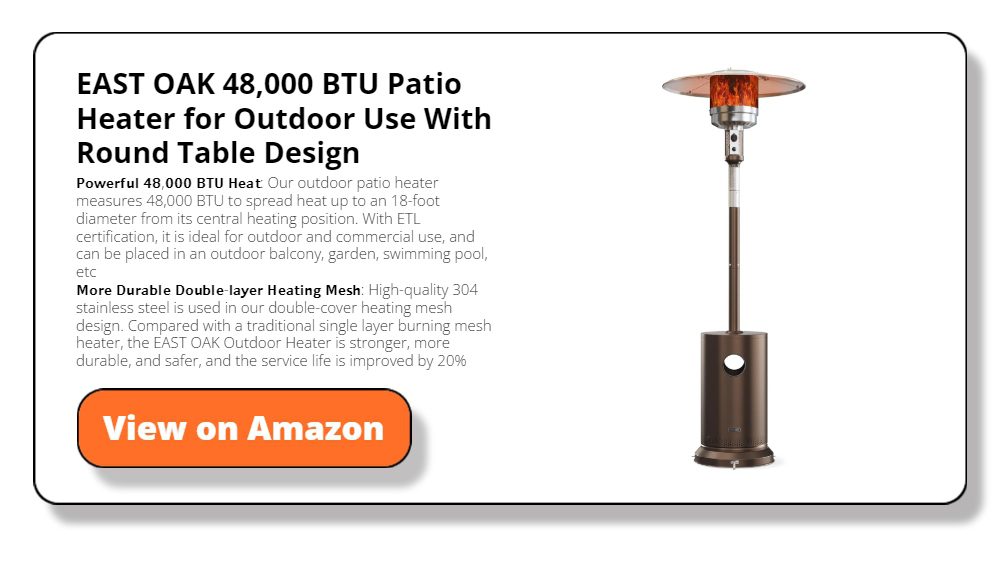
Combination Enclosure
A combination enclosure merges the benefits of screened and glass-enclosed patios, offering a versatile and adaptable space for any season. This hybrid approach provides the open-air feel of a screened-in patio with the option of a full enclosure during colder or wetter months. By integrating removable panels or windows, you can easily transition your patio from a breezy outdoor retreat to a cozy enclosed patio, making it a perfect choice for homeowners seeking flexibility and year-round enjoyment.
Materials and Tools Needed
To build a combination enclosure for your patio, gather these materials and tools:
- Aluminum or Wooden Framing: For constructing the main structure.
- Screen Panels: Durable mesh screens for open-air sections.
- Removable or Sliding Glass Panels: Tempered glass for the enclosed sections.
- Hinges and Locks: To secure the removable panels.
- Weatherstripping: For sealing around glass panels and frames.
- Drill, Screws, and Anchors: For assembly and attachment.
- Measuring Tape and Level: To ensure accurate dimensions and alignment.
Step-by-Step Guide to Building a Combination Enclosure
- Design Your Enclosure
- Determine the layout and dimensions of your enclosed patio. Plan which sections will be screened and which will feature glass panels.
- Decide on the placement and size of removable or sliding glass panels, ensuring they fit seamlessly with the screened areas.
- Build the Frame
- Cut the framing material to match your patio’s dimensions. Assemble the frame, securing it with screws and checking with a level to ensure it’s square and stable.
- Install the frame securely onto your patio foundation or existing structure, making sure it can support both the screens and the glass panels.
- Install the Screen Panels
- Attach the screen panels to the designated open-air sections of the frame. Use a screen spline and a spline roller to secure the screens tightly in place.
- Check that the screens are taut and free of wrinkles or gaps.
- Mount the Removable or Sliding Glass Panels
- Position the glass panels into the frame. For sliding panels, install the track system to allow smooth operation. For removable panels, use hinges and locks for easy attachment and removal.
- Ensure that all glass panels fit snugly and securely, providing a clear, unobstructed view and protection when closed.
- Seal and Finish the Enclosure
- Apply weatherstripping around the edges of the glass panels and frames to prevent drafts and ensure a tight seal when closed.
- Test the movement of the sliding or removable panels to confirm they operate smoothly and lock securely.
Tips for a Successful Combination Enclosure
- Select High-Quality Materials: Use durable, weather-resistant materials for both the screens and glass panels to ensure long-lasting performance.
- Consider Seasonal Use: Design your enclosed patio to accommodate different seasons. Removable panels can be stored during warm months and reinstalled as needed for colder weather.
- Maintain Flexibility: Keep the enclosure versatile by allowing easy conversion between an open and closed space. This adaptability maximizes the usability of your patio throughout the year.

A combination enclosure offers a dynamic solution for those who want the freedom of an open patio with the protection of an enclosed space. This type of enclosed patio provides a comfortable and stylish area to relax, entertain, and enjoy the beauty of your outdoor surroundings in any weather. With thoughtful design and execution, your DIY combination enclosure will become a treasured extension of your home.
Permanent Roof with Partial Walls
Adding a permanent roof with partial walls to your patio strikes a perfect balance between shelter and openness. This type of enclosed patio protects from the elements while maintaining an airy feel, making it an ideal space for year-round outdoor enjoyment. With solid coverage overhead and low walls around the perimeter, you can create a cozy, defined area that blends seamlessly with your garden or yard.
Materials and Tools Needed
For constructing a permanent roof with partial walls for your enclosed patio, you’ll need:
- Roofing Material: Options include metal, shingles, or polycarbonate sheets.
- Support Beams and Posts: Strong wood or metal to support the roof structure.
- Partial Wall Materials: Wood, brick, or decorative panels for the lower sections.
- Fasteners: Screws, bolts, and anchors for assembly.
- Concrete or Stone: For a solid foundation if needed.
- Drill, Saw, and Measuring Tape: For cutting and assembling materials.
- Level and Square: To ensure accurate alignment and stability.
Step-by-Step Guide to Building a Permanent Roof with Partial Walls
- Plan Your Enclosed Patio Design
- Measure the area where you’ll build your enclosed patio, taking note of any existing structures or features.
- Decide on the height of the partial walls and the type of roofing material that best suits your home and climate.
- Prepare the Foundation
- If your patio doesn’t have an existing foundation, lay a solid base using concrete or stone. This will provide a stable and level surface for the support posts and walls.
- Ensure the foundation is even and can bear the weight of the roof and partial walls.
- Construct the Support Framework
- Install the support posts at each corner of your patio, securing them deeply into the ground or foundation. These posts will hold up the roof structure.
- Connect the posts with beams across the top, forming the framework for the roof. Use a level to keep everything straight and aligned.
- Build the Partial Walls
- Measure and cut materials for the partial walls, typically ranging from knee height to waist height. These walls can be constructed from wood, brick, or decorative panels.
- Attach the partial walls to the support posts and secure them firmly. Make sure they are evenly spaced and provide adequate support for the overall structure.
- Install the Permanent Roof
- Cut and prepare your chosen roofing material to fit the top of the frame. If using metal or polycarbonate sheets, ensure they overlap slightly to prevent leaks.
- Secure the roofing material to the beams with screws or bolts. Check that the roof is watertight and slopes slightly to allow for proper drainage.
- Finish and Seal the Enclosure
- Apply sealant around the roof edges and where the partial walls meet the support posts to protect against weather.
- Paint or stain the partial walls and support posts to enhance durability and match your home’s aesthetic.
Tips for a Successful Enclosed Patio with Partial Walls
- Select Durable Materials: Choose roofing and wall materials that can withstand your local weather conditions and provide long-lasting protection.
- Consider Lighting and Ventilation: Install outdoor lighting fixtures under the roof and ensure there’s enough airflow to keep the enclosed patio comfortable.
- Personalize the Space: Add furniture, plants, or decor to create a welcoming and functional area that reflects your style and suits your needs.
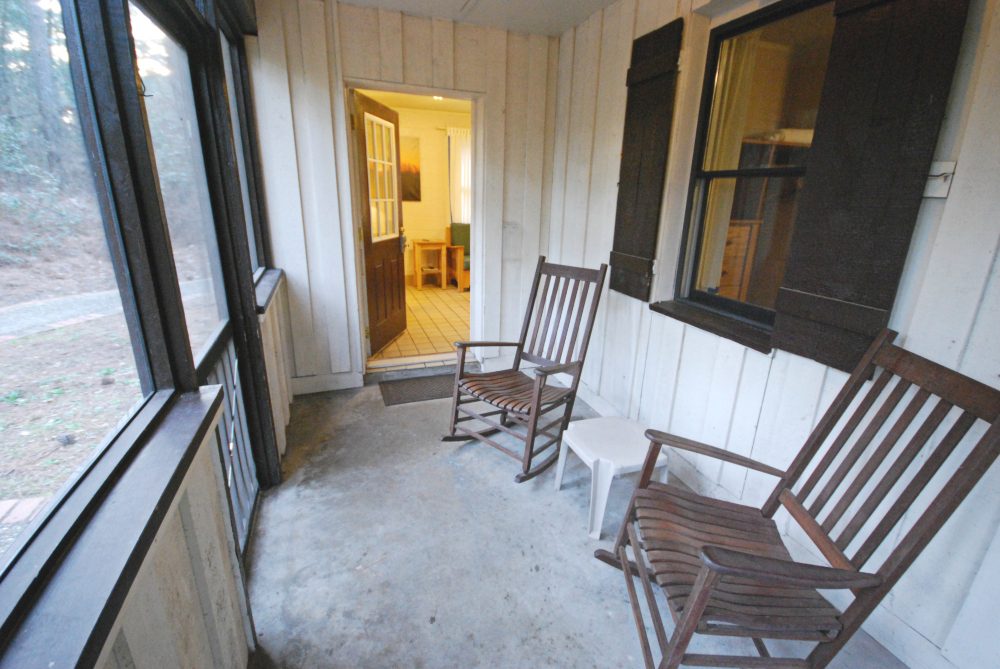
A permanent roof with partial walls transforms your patio into a versatile enclosed patio that’s perfect for both relaxation and entertaining. This design offers the shelter of a traditional room while retaining the openness of outdoor living. With careful planning and attention to detail, your DIY-enclosed patio will become a cherished extension of your home, providing comfort and enjoyment in all seasons.
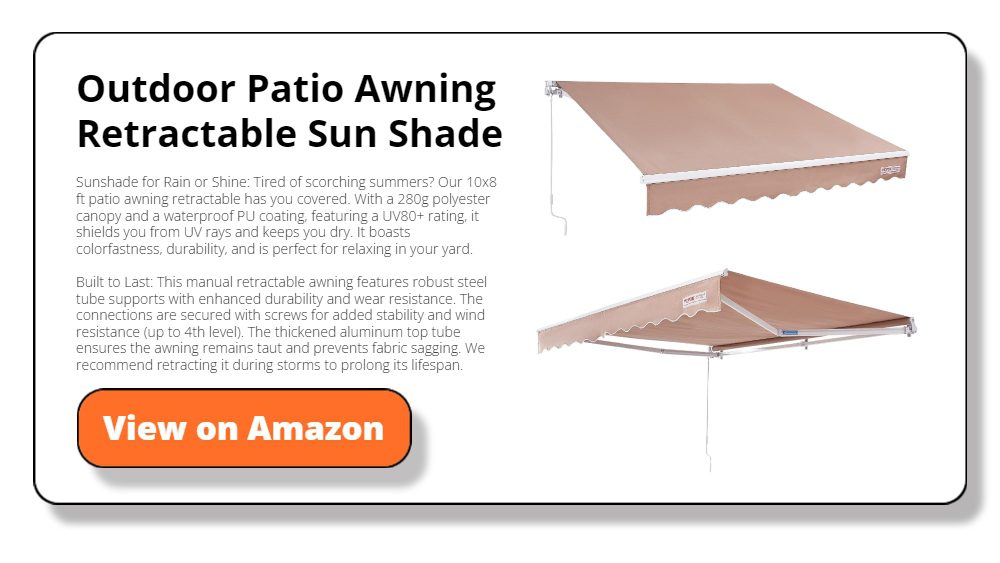
Convertible Enclosure Using Canvas or Vinyl
A convertible enclosure using canvas or vinyl offers a versatile solution for those who want an adaptable outdoor space. This type of enclosed patio provides the flexibility to enjoy open-air living during warm weather and quick, cozy shelter when conditions change. By using roll-up or retractable materials, you can easily transform your patio into a protected retreat or an open, breezy area as needed.
Materials and Tools Needed
To build a convertible enclosure for your patio using canvas or vinyl, gather these materials and tools:
- Canvas or Vinyl Sheets: Choose durable, weather-resistant fabric suitable for outdoor use.
- Retractable or Roll-Up Mechanism: Systems like curtain tracks or roll-up blinds for easy operation.
- Mounting Hardware: Hooks, brackets, and screws to attach the fabric and mechanisms to your structure.
- Support Poles or Frames: Optional, for additional stability if your patio lacks a fixed structure.
- Measuring Tape and Level: For precise measurements and alignment.
- Drill, Screws, and Anchors: For securing the mechanisms and fabric.
Step-by-Step Guide to Building a Convertible Enclosure
- Plan Your Enclosed Patio Design
- Measure your patio area to determine the dimensions for your canvas or vinyl panels. Decide where the retractable or roll-up mechanisms will be installed.
- Consider how you want the panels to open and close. This will help in choosing the right type of mechanism, whether it’s a track system or simple roll-up blinds.
- Install the Mounting Hardware
- Attach the mounting brackets or hooks to your patio’s support structure. If you’re using poles or frames, ensure they are securely anchored to the ground or existing patio framework.
- Position the brackets or hooks at intervals along the top edge of the patio to support the weight of the canvas or vinyl.
- Prepare and Attach the Canvas or Vinyl Panels
- Cut the canvas or vinyl sheets to the measured dimensions of your patio area. Allow for extra material at the edges for securing the panels.
- Install the retractable or roll-up mechanism. For track systems, slide the canvas or vinyl panels into the tracks. For roll-up systems, attach the panels to the top of the mechanism and ensure they can be easily rolled up and down.
- Secure the Bottom Edges
- Attach the bottom edges of the panels to the patio or ground using fasteners, ties, or weights. This step prevents the fabric from flapping in the wind and keeps the enclosed patio stable.
- Make sure the panels are taut and can be easily rolled up or retracted when you want to open the space.
- Test the Flexibility
- Operate the retractable or roll-up system to ensure smooth movement. Adjust the tension and alignment as needed to allow easy conversion between an open and enclosed patio.
- Check all attachments and fasteners to confirm they are secure and capable of holding the fabric in place.
Tips for a Successful Convertible Enclosed Patio
- Choose High-Quality Fabric: Opt for heavy-duty, UV-resistant canvas or vinyl to withstand various weather conditions and provide long-lasting use.
- Consider Accessibility: Ensure that the mechanisms for rolling up or retracting the panels are easy to reach and operate, even when the panels are in use.
- Enhance Usability: Add ties or clips to secure the panels when they are rolled up, keeping them neatly out of the way when you want an open patio.
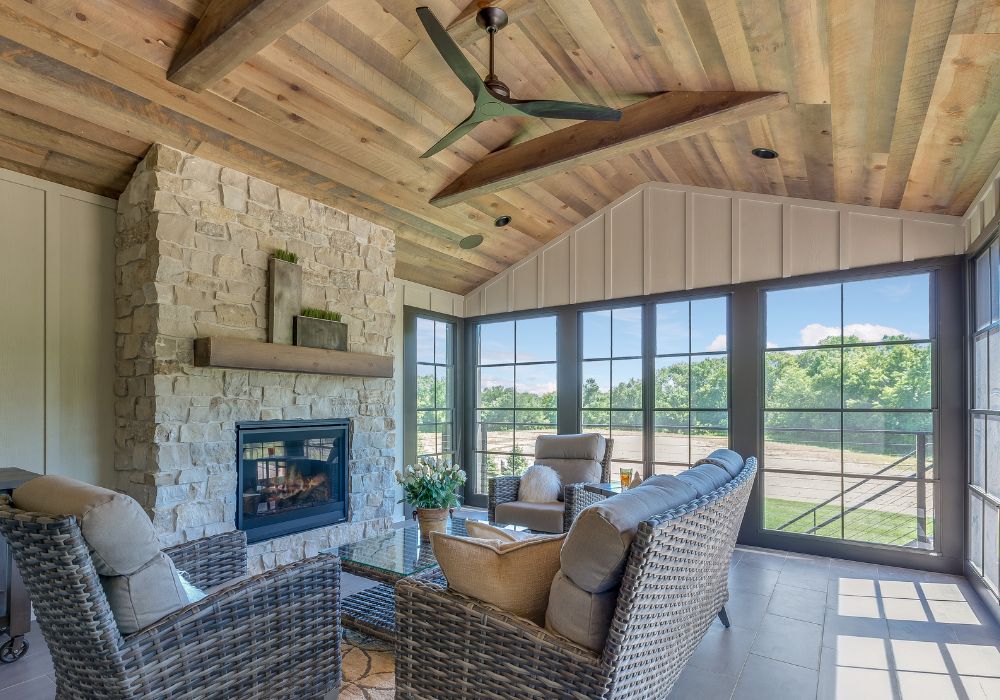
A convertible enclosure using canvas or vinyl transforms your patio into a multifunctional enclosed patio that adapts to your needs and the weather. This design allows you to enjoy the best of both worlds: open-air freedom on sunny days and cozy protection when it’s needed. With thoughtful planning and installation, your DIY enclosed patio will become a flexible and inviting space, perfect for any season.
Conclusion
You have a variety of choices to improve your outdoor living area with these five enclosed patio designs. Every method, whether it’s the light-filled experience of a screened-in space, the modern appearance of a glass enclosure, the adaptability of a combination design, the robust shelter of a permanent roof with partial walls, or the flexible comfort of a convertible enclosure, has special advantages. Your patio may be a lovely and useful extension of your house with some thought and design.

